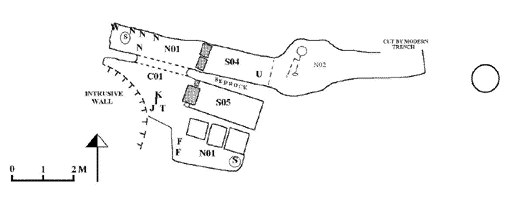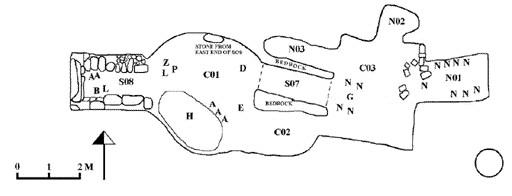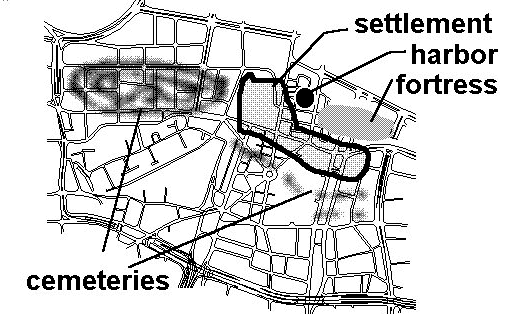
|
|
Archeological Resource Management in the Beirut Central District Appendix 1 The Iron Age cemetery in BEY 018 (Excerpt from our report on the excavations in 1995, to be published in Bulletin d'Architecture et Archeologie Libanais --BAAL)
Barbara Stuart and Hans H. Curvers The period VI (= Iron Age) cemetery includes thirteen shaft graves. Their deep shafts are cut out in the bedrock (average dimensions 200 x 80 x 400 cm). The orientation is roughly W/NW to E/SE. Some shafts are connected to caves or chambers, others have an inhumation on the bottom. Within the limits of this report we will discuss five graves, all of which are located in the area that has to give way to an electrical power substation. Shaft 04 (with chambers N01 and N02; Figure 1) was the first shaft to be excavated of a series of period VI and V shafts, tombs and caves, all cut out in the bedrock. The shaft itself (224 x 94 x 314 cm) did not yield any special finds or skeletal material. It gives access to two chambers, N01 in the west and N02 in the east. Figure 1 (enlargement) Chamber N01 is rectangular in plan (310 x 70 x 93 cm) and is oriented WNW to ESE, like the shaft. The southern wall was partially preserved to a length of 70 to 75 cm from the northwestern corner. The rest of the wall is preserved as a 5-10 cm high ridge visible on the bottom of the chamber. Above it is now the opening between chamber N01 of Shaft 4 and chamber C01 of adjoining Shaft 5. The chamber was closed off from the shaft by a wall made of three courses of limestone blocks (97 x 85 x 16 cm). Skeletal material was found in the part of the chamber next to the partition wall with chamber C01 of Shaft 5. Its absence in the rest of the chamber may suggest that it has been deliberately removed, possibly by grave robbers or the people who built the wall of the cistern cut through chamber C01 of Shaft 5. This means that the bone material from Shaft 5 C01 may contain the post-cranial skeleton of Shaft 4 N01. N01 yielded remains of the skull, cervical vertebrae and the right shoulder, all in extremely bad state. The remains belong to an adult individual, older than 30 years based on closing of sutures. Further specification not possible, sex unknown. In between the human skeletal remains one complete roundel of animal bone was found as well as some fragments. The roundels may have been used in a burial ritual or have decorated a burial shroud or coffin. No specific pattern was recognizable. Between and next to the skeletal material a few metal objects (fig. 1:N) were found and pieces of wood (fig. 1:W). The metal objects are nails -- some with wood fragments attached to them -- and flat objects of which function and original shape are unknown. The position of these objects may indicate they were part of a wooden coffin. Under the skeleton the earth was very black, perhaps also remains of wood. No objects were found in this chamber that provide evidence for a precise date of the inhumation. On the bottom of the shaft, on the east side, a Hellenistic Unguentarium was found. This find suggests that the burial in N01 is Hellenistic or earlier. Chamber N02 is located on the east side of Shaft 4, not separated from it by a wall when we found it. This may be the result of robbery (the skeletal remains were heavily disturbed). The chamber is long and narrow (490 x 90-190 x 66-96 cm). The rectangular chamber has slightly rounded corners between ceiling and walls. The skeleton was found in the western part of the chamber, in a depression (depth 30 cm). Limestone chips fallen from the ceiling covered the human bones. The skeletal remains belong to a young male individual (c. 20-25 years old). The bones from skull, right arm and upper body until the lumbar vertebrae were found in situ, the rest of the skeleton was either missing or fragmented. Some bones of the feet were found next to the head. The bones have a remarkable orientation; almost N-S while the orientation of the chamber is almost E-W. This could mean that grave robbery took place shortly after the burial and that the body was pushed aside. An even later disturbance would be responsible for the absence of the lower skeleton. A Hellenistic Unguentarium was found in front of the entrance of this chamber, probably lost by the grave robbers. Shaft 5 is almost parallel to shaft 4 (225 x 100 x 403 cm), its orientation is WNW - ESE. The upper 120 cm of the walls are worked into a straight surface, below this part the geological composition of the bedrock changes (alternating layers of compact limestone and gray friable rock) resulting in irregular wall faces. Towards the bottom the orientation of the shaft shifts slightly to NW - SE. At 266 cm from the top of the shaft the skeleton of an adult individual was found, articulated but in a very bad state of preservation. Ten cm above the skeleton two rows of roundels of animal bone were found. Each row consisted of thirty roundels with an interdistance of 7 cm. Another row of roundels was found on the neck, vertebral column and between the legs. This row was separated from the body by a thin layer of organic material. These rows of roundels are interpreted as part of the decoration of a wooden coffin. The central part of the lid collapsed first under the pressure of the soil and the roundels fell on the body. The edges of the coffin withstood the pressure of the earth longer and this resulted in a different elevation of the other two rows of roundels. This burial was found on the same level as the top of a limestone block (80 x 50 x 40 cm) which blocked the entrance to chamber C01 and was standing on the short side. Right behind the entrance (in fact a lower jaw was found stuck to the limestone block when this was removed) a large number of human bones were found, not one bone in situ and mixed with animal bones (a.o. dog). Throughout the cave this pattern was observed; human bones of several individuals, roundels and animal bones. In the S-W corner of the chamber a wall built of five courses of limestone blocks was found; the wall belongs to a (bell-shaped) well constructed in a later period. Next to Shaft 5, separated from it by three large limestone blocks there is a niche (240 x 70 x 80). In front of it an incense burner was found, together with fragments of three Hellenistic female statuettes. The pinkish red paint was still preserved in the folds of the peplos. Two more figurines were found in the niche. The skeletal material from the niche belongs to a male adult, age unknown. The bones from C01 still have to be analyzed to establish a minimum number of individuals, their age and sex. Figure 2 (enlargement)
Chamber 01 is 180 cm high and is circular in plan (diameter 360 cm). The chamber was filled with a thick layer of debris consisting of fine to medium fragments of limestone. We assume that through the ages this material fell down from the ceiling. The absence of working marks on the ceiling corroborates this hypothesis. During the excavation of the chamber two layers with objects were recognized. The upper layer of dark brown material contained some human bones and a few Roman oillamps. The quality of the human bones has to be compared with the remains clearly dating from the Iron Age, Hellenistic Period and Roman period, before we can conclude that the grave complex was used in the Roman period. A vent hole (natural or artificial) may be responsible for the presence of the Roman material. The lower layer was yellow to white and contained objects that were originally associated with the burial of Shaft 8. An Attic cup, ceramic plates of the Hellenistic period, and three bronze anklets. Human bones were retrieved from both the upper and the lower layer. The date of the bones in the upper layer are as yet unclear. In the lower layer, consisting of yellow to white material, human skeletal remains belonged to more than one individual. None of their skeletons was articulated. Roundels were found in large quantities among the human bones. A interesting find was a piece of bone used to cut the roundels from. Our animal bone specialist, Chiara Cavallo, has identified the roundels as originating from long bones, the radius of the species Equus and the tibia of the species Bos. Chamber 3 is almost rectangular in plan (320 x 300 x 130 cm). The cave is provided with three niches in the eastern, northern and northwestern side. The walls of the cave are cut vertically. At first discovery the cave was filled with a heap of brown soil in the entrance. Under this heap of brown soil some hewn limestone blocks and iron nails were found. The presence of the blocks suggests that the niches were closed with walls. A part of the closing wall of niche N1 was found in situ. The iron nails distributed in a rectangular pattern suggest the presence of a wooden door. The heap of brown soil probably fell into the cave when the wooden door closing the cave collapsed. Shaft 08 was cut out into the bedrock, the plan of the shaft is almost square (260 x 200 cm), which differs from the other graves in the area. At a depth of 110 cm a cover of long rectangular stones was exposed. This cover was touched by the people that cut the chamber associated with Shaft 7. The walls on the long side carried the cover slabs. These walls and a third on the short side were made of hewn limestone of irregular size and natural stones, deposited in three courses. The fourth side wall consisted of a large boulder on edge. Due to the construction of the western chamber (C03) associated with Shaft 7 this boulder was pulled aside against the northern side of the chamber. Inside the three walls a mixture of human bones, roundels and objects was found. The human bones were not articulated. The contents of the grave suggest an Iron Age date. Two bronze anklets, a lamp, and roundels all can be assigned to this period. In chamber 1 of Shaft 7 the constructors left more of the contents of this grave: cup with handles (Attic?), several ceramic lamps and plates, a pierced jug, a small amphora and three bronze anklets. The finds in BEY 018 do warrant a hypothetical lay-out of Beirut in the late Iron Age (Fig. 3). With the results obtained through the excavations of dr Leila Badre in BEY 003, dr Husayn Sayyegh in BEY 010, dr. Naji Karam in BEY 013 and dr Uwe Finkbeiner and dr Helen Sadr in BEY 020 we sketched the lay-out of the Iron Age setttlement in Beirut (Fig. 3). During excavations at our infrastructure sites we were able to test this hypothesis. In the sites along Weygand Street we have been able to expose traces of the later Iron Age settlement. On Martyrs Square (BEY 066) we have recorded some burials which displayed a mortuary ritual that can be compared to the burial recorded in Shaft 5 at BEY 018. The low number of burials exposed in this area (130 x 60 m) does not warrant to reconstruct this site as a registered in the area indicated on our sketch as cemetery. cemetery. Whereas the total of exposed and recorded tombs in the area of BEY 018 increases with the building activities on the lots along the ancient coastal line. To date 25 rock-cut tombs have been ??
Figure 3
|

Created 970421


